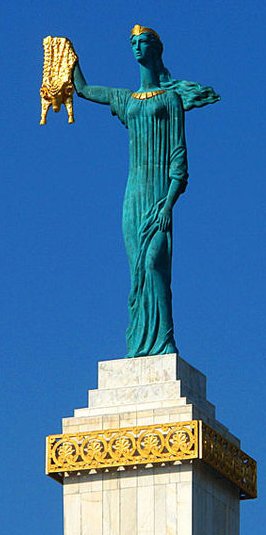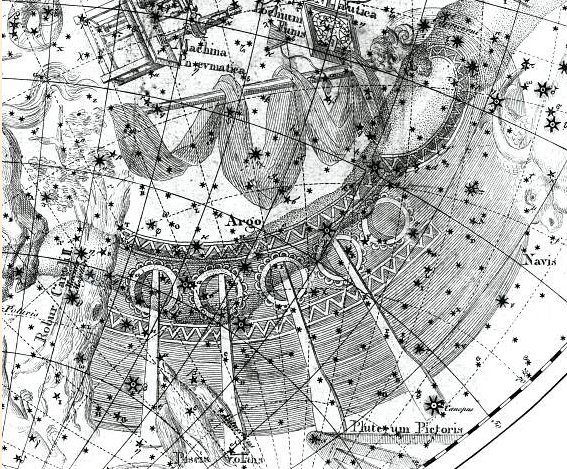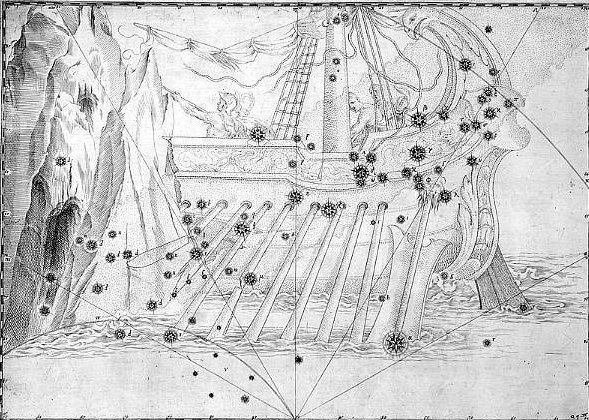When the wooden clappers announced the household fires had to be extinguished it was early in April. I think this means it was a time connected with the return of the Sun: ... In China, every year about the beginning of April, certain officials called Sz'hüen used of old to go about the country armed with wooden clappers. Their business was to summon the people and command them to put out every fire. This was the beginning of the season called Han-shih-tsieh, or 'eating of cold food'. For three days all household fires remained extinct as a preparation for the solemn renewal of the fire, which took place on the fifth or sixth day after the winter solstice [Sic!]. The ceremony was performed with great pomp by the same officials who procured the new fire from heaven by reflecting the sun's rays either from a metal mirror or from a crystal on dry moss. Fire thus obtained is called by the Chinese heavenly fire and its use is enjoined in sacrifices: whereas fire elicited by the friction of wood is termed by them earthly fire, and its use is prescribed for cooking and other domestic purposes ... Like archaic China and certain Amero-Indian societies, Europe, until quite recently, celebrated a rite involving the extinguishing and renewal of domestic fires, preceded by fasting and the use of the instruments of darkness. This series of events took place just before Easter, so that the 'darkness' which prevailed in the church during the service of the same name (Tenebrae), could symbolize both the extinguishing of domestic fires and the darkness which covered the earth at the moment of Christ's death. In all Catholic countries it was customary to extinguish the lights in the churches on Easter Eve and then make a new fire sometimes with flint or with the help of a burning-glass. Frazer brings together numerous instances which show that this fire was used to give every house new fire. He quotes a sixteenth-century Latin poem in a contemporary English translation, from which I take the following significant lines: On Easter Eve the fire all is quencht in every place, // And fresh againe from out the flint is fecht with solemne grace. Then Clappers cease, and belles are set againe at libertée, // And herewithall the hungrie times of fasting ended bée ... When the household fires no longer were burning like small suns, emitting warmth and light, the night sky with all its stars, including the myriad in the Milky Way, would return into view after having been in the shadows only, and the magnificent beauty of the heavens would be perceived after the eyes had returned to their nighttime sensitivity. And when this had happened it would be observed from the positions of the major stars what date it really was, as had been decided very long ago. This could explain why there was a paradoxical jump in time from early April to late December. To go from early daytime in April to the corresponding night half a year later 183 (= 366 / 2) days should be added and it would then become evident that precession had moved the Sun 68 days earlier in the year, which meant also these 68 days had to be added because the stars had moved so many nights ahead in relation to where the Sun at present was. 183 + 68 = 251. On Easter Island the equinoxes may have been more important than the solstices, and if so the corresponding event ought to be presented in the glyph text as 'upside down', i.e. with the date for the return of spring Sun deduced from the ancient star dates. September 22 (spring equinox south of the equator) - 68 = 197 (*JULY 16). Accordingly the current Sun would return when the star date observed in the night was 197 - 80 + 183 = *300 (*JANUARY 14). I.e., the Sun would return from the northern hemisphere in day 265 (September 22) because this date could be deduced from the ancient date *JANUARY 14 (*300) and the works of the precession. These dates were fixed and never changed. But the Sun came earlier and earlier, and once in a while the key number of the precession - which happened to be regarded as 68 at the time of rongorongo - had to be increased in order to keep day 265 (= 365 - 100) at the correct distance from *JANUARY 14. *JANUARY 14 + 68 = *368 (March 23) and *368 - 183 + 80 = 265 (September 22). ... This island was once a great land. The reason it became so small is because Uoke lifted the earth with a (mighty) pole and then let it sink (into the sea). It was because of the very bad people of Te Pito O Te Henua that Uoke lifted the land (and let it crumble) until it became very small. From the uplifted Te Pito O Te Henua, (they) came to the landing site of Nga Tavake, to Te Ohiro. In Rotomea (near Mataveri) they disembarked and climbed up to stay at Vai Marama (a waterplace near Mataveri). During the next month, they moved on to Te Vare (on the slope of the crater Rano Kau). When they saw that the (land-) lifting Uoke also approached (their present) island, Nga Tavake spoke to Te Ohiro: 'The land is sinking into the sea and we are lost!' But Te Ohiro warded off the danger with a magic chant. In Puku Puhipuhi, Uoke's pole broke, and, in this way, at least Nga Tavake's landing site remained (of the formerly great land) ... *JANUARY 14 - September 22 = *300 - (265 - 80) = *115 (*JULY 14). ... Later on in this series of rituals, the Chorti go through a ceremony they call raising the sky. This ritual takes place at midnight on the twenty-fifth of April and continues each night until the rains arrive. In this ceremony two diviners and their wives sit on benches so that they occupy the corner positions of the cosmic square. They take their seats in the same order as the stones were placed, with the men on the eastern side and the women on the west. The ritual actions of sitting down and lifting upward are done with great precision and care, because they are directly related to the actions done by the gods at Creation. The people represent the gods of the four corners and the clouds that cover the earth. As they rise from their seats, they metaphorically lift the sky. If their lifting motion is uneven, the rains will be irregular and harmful ...
... The name 'lynx' originated in Middle English via Latin from Greek word 'λύγξ', derived from the Indo-European root '*leuk-', meaning 'light, brightness' ... ... Between the front side of your head (adorned with a pair of eyes) and its back side (covered up by hair) there is a pair of ears. They are positioned at dawn (right ear) respectively at the horizon in the west (left ear). When the daylight is insufficient the ears are good supporters for keeping you alive ...
On side a (the front side) of the G tablet there seems to be a 'compressed' Sun calendar for the year, I have suggested. In view of the work of the precession (the pole of Uoke) we can guess this compression should measure 68 days due to how the stars had advanced in the year, in a way consuming daytime.
180 (Ga7-11) - 57 (Ga2-27, π) = 123 = 195 (July 14) - (68 + 4). Since the time of Gregory XIII precession had pushed 4 more days into the sea. ... Gregory dropped 10 days to bring the calendar back into synchronisation with the seasons. Accordingly, when the new calendar was put in use, the error accumulated in the 13 centuries since the Council of Nicaea [325 A.D.] was corrected by a deletion of ten days. The Julian calendar day Thursday, 4 October 1582 was followed by the first day of the Gregorian calendar, Friday, 15 October 1582 (the cycle of weekdays was not affected) ... So the shift in the date of the equinox that occurred between the 4th and the 16th centuries was annulled with the Gregorian calendar, but nothing was done for the first four centuries of the Julian calendar. The days of 29 February of the years AD 100, AD 200, AD 300, and the day created by the irregular application of leap years between the assassination of Caesar and the decree of Augustus re-arranging the calendar in AD 8, remained in effect ... Gregory dropped 10 days to bring the calendar back into synchronisation with the seasons. Accordingly, when the new calendar was put in use, the error accumulated in the 13 centuries since the Council of Nicaea was corrected by a deletion of ten days ... There were 4 faulty precessional days before the Council of Nicaea which had not been corrected by the Pope. Therefore 68 above can be seen as reflecting 64 + 4, i.e. the number according to the Gregorian calendar (64) updated with 4 since the time of the Pope. But then also the faulty days before the Council of Nicaea had to be added because the 'canoe' of the Pople was crooked - cfr the name of λ Virginis at 227 (where 22 / 7 = 3.14) = the opposite side of the sky compared to Mira at 2-14 (45). ... There is a couple residing in one place named Kui [Tui = the Three Stars at the equator in the center of Orion] and Fakataka [Completing a Circuit]. After the couple stay together for a while Fakataka is pregnant. So they go away because they wish to go to another place - they go. The canoe goes and goes, the wind roars, the sea churns, the canoe sinks.
Kui expires while Fakataka swims. Fakataka swims and swims, reaching another land. She goes there and stays on the upraised reef in the freshwater pools on the reef, and there delivers her child, a boy child. She gives him the name Taetagaloa [Not Tagaroa]. When the baby is born a golden plover flies over and alights upon the reef. (Kua fanau lā te pepe kae lele mai te tuli oi tū mai i te papa). And so the woman thus names various parts of the child beginning with the name 'the plover' (tuli): neck (tuliulu), elbow (tulilima), knee (tulivae). They go inland at the land. The child nursed and tended grows up, is able to go and play. Each day he now goes off a bit further away, moving some distance away from the house, and then returns to their house. So it goes on and the child is fully grown and goes to play far away from the place where they live. He goes over to where some work is being done by a father and son. Likāvaka is the name of the father - a canoe-builder, while his son is Kiukava. Taetagaloa goes right over there and steps forward to the stern of the canoe saying - his words are these: 'The canoe is crooked.' (kalo ki ama). Instantly Likāvaka is enraged at the words of the child. Likāvaka says: 'Who the hell are you to come and tell me that the canoe is crooked?' Taetagaloa replies: 'Come and stand over here and see that the canoe is crooked.' Likāvaka goes over and stands right at the place Taetagaloa told him to at the stern of the canoe. Looking forward, Taetagaloa is right, the canoe is crooked. He slices through all the lashings of the canoe to straighten the timbers. He realigns the timbers. First he must again position the supports, then place the timbers correctly in them, but Kuikava the son of Likāvaka goes over and stands upon one support. His father Likāvaka rushes right over and strikes his son Kuikava with his adze. Thus Kuikava dies. Taetagaloa goes over at once and brings the son of Likāvaka, Kuikava, back to life. Then he again aligns the supports correctly and helps Likāvaka in building the canoe. Working working it is finished ...
... The Symplegades ... or Clashing Rocks, also known as the Cyanean Rocks, were, according to Greek mythology, a pair of rocks at the Bosphorus that clashed together randomly. They were defeated by Jason and the Argonauts, who would have been lost and killed by the rocks except for Phineus' advice. Jason let a dove fly between the rocks; it lost only its tail feathers. The Argonauts rowed mightily to get through and lost only part of the stern ornament. After that, the Symplegades stopped moving permanently ...
 ... The Argonauts, with the Golden Fleece on board, had to pass the Symplegades, the clashing rocks. Once a ship with its crew came through unharmed - so the 'blessed ones' (makaroi) had decided long ago - the Symplegades would stay fixed, and be clashing rocks no longer. After that 'accepting the novel laws of the fixed earth', they should 'offer an easy passage to all ships, once thay had learnt defeat'. This is only one station on the long 'opening travel' of the Argonauts transporting the Golden Fleece (of a ram), undertaken in all probability to introduce the Age of Aries, but it demonstrates best the relevant point, namely, 'the novel laws' ...
|
|||||||||||||||||||||||||||||||||||||||||||||||||||||||||||||||||||||||||||||||||||||||||||||||||||||||||||||||||||||||||||||||||||||||||||||||||||||||||||||||||||||||||||||||||||||||||||||||||||||||||||||||||||||||||||||||||||||||||||||||||||||||||||||||||||||||||||||||||||||||||||||||||||||||||||||||||||||||||||||||||||||||||||||||||||||||||||||||||||||||||||||||||||||||||||||||














 1 winter solstice
1 winter solstice

















